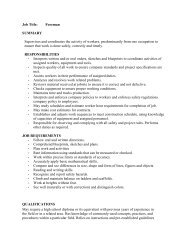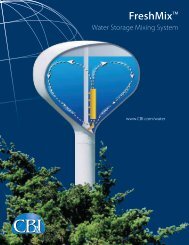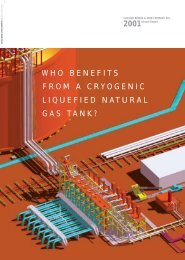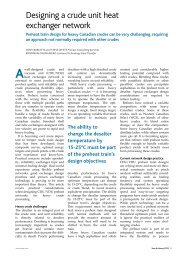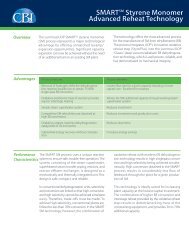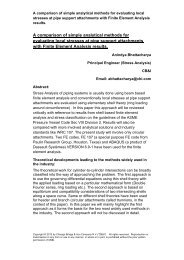In this issue - CB&I
In this issue - CB&I
In this issue - CB&I
You also want an ePaper? Increase the reach of your titles
YUMPU automatically turns print PDFs into web optimized ePapers that Google loves.
Special Features<br />
This 2.5-megawatt turbine generator was built for the Bureau of<br />
Reclamation of Colorado. CB&I also built a fifth all-welded steel tower<br />
for Boeing and Pacific, Gas & Electric. A 2.5-megawatt turbine generator,<br />
similar in size and appearance to the WTGs in Washington and<br />
Wyoming, <strong>this</strong> WTG was built on the windswept hills of Solano County.<br />
<strong>In</strong> addition, for Boeing/Hawaiian Electric, CB&I built a 192' tall tower, 15-<br />
18' in diameter, at Kahuku, Hawaii. The blade was 310' in diameter and<br />
the turbine generator was a type Mod 5 (5MW). CB&I has also built a<br />
variety of other specialized, large metal structures. These have included<br />
research wind tunnels, aircraft engine test facilities, space simulation<br />
chambers for testing satellites and their components, aluminium laser<br />
target chambers and nuclear reactor vessels.<br />
Major Offshore Contractor<br />
Offshore oil and gas forms one of the core business areas of CB&I John<br />
Brown, part of CB&I Process & Technology Group. CB&I John Brown is<br />
one of the leading offshore engineering and project management<br />
companies, and can provide everything from field concept screening<br />
studies through to realization of full EPC offshore projects. CB&I John<br />
Brown is a 900 strong group of people with a heritage stretching back<br />
through Earl and Wright, Humphreys and Glasgow and John Brown<br />
itself. Our projects span all major offshore areas of the world. The<br />
geographical areas covered by CB&I John Brown projects represent a<br />
diverse range of industry and local requirements, and it is a corporate<br />
culture of CB&I that it establishes in each of its operational areas an<br />
organization and commitment locally which ensures real added value<br />
both to its client and to the local community.<br />
CB&I John Brown Offshore Wind Energy Experience<br />
We have been active in pursuing the emerging offshore wind energy<br />
market in Europe for the last 10 years. The parallels with offshore oil and<br />
gas are obvious and the offshore industry has much to offer. There are<br />
some significant differences, though. Wind farms are located in shallow<br />
water, often on sandbanks, where shipping is not an <strong>issue</strong>. Here,<br />
breaking waves add significantly to the environmental loads, and the<br />
dynamics of the turbine are the dominant fatigue loading. We are<br />
transferring the best of our offshore oil and gas structural, marine and<br />
foundation technologies into the design of offshore wind farms.<br />
However, due to the unmanned nature of these facilities cost must be<br />
kept to a minimum. Offshore wind speeds are higher than coastal wind<br />
speeds at sea level. Ten kilometers from the shore, speeds may be 25%<br />
higher than at the coast and there are large areas of the North Sea and<br />
Baltic with wind speeds above 8 m/s (at 50m). <strong>In</strong> theory, estimating<br />
offshore winds should be straightforward, as the surface of the sea is<br />
more homogeneous than the land, but in practice the influence of land<br />
features can extend a considerable distance (c. 50 km or more) out to<br />
sea. This makes estimation difficult in the zone where most early wind<br />
farms will be built. For <strong>this</strong> reason Met masts are installed prior to wind<br />
farm development to collect <strong>this</strong> data, and allow optimization of the<br />
wind farm layout. The design of offshore wind turbines demands<br />
knowledge about wave conditions, particularly the extreme wave<br />
heights. Wave heights generally increase with wind speed although<br />
there is a time lag, so that extreme winds and waves do not necessarily<br />
coincide. Wave heights increase with water depth and so the extreme<br />
waves vary with geographical location. The design of offshore wind<br />
farms may need to take into account the possibility of ice formation in<br />
the sea, particularly in more northern latitudes. This affects foundation<br />
design, the design of the structure (to protect it against possibility of<br />
collisions with ice floes) and operation and maintenance strategies. <strong>In</strong><br />
regions where the sea freezes over completely, <strong>this</strong> is likely to influence<br />
estimates of the offshore resource, simply because access for<br />
maintenance purposes may be completely impossible for periods of up<br />
to five months. The logistics of installation are also an order of<br />
magnitude more complex because of the multiple activities necessary<br />
for example, a thirty unit wind farm requires in excess of 150 lifts, with<br />
continuous construction operations offshore for up to six months.<br />
<strong>In</strong>deed, many people believe that the availability of suitable installation<br />
vessels may be one of the key constraints that finally determine the rate<br />
of deployment of offshore wind farms, both in the UK and in Europe.<br />
Based on the existing market, our current strategy is to pursue contracts<br />
for the supply and installation of the Balance of Plant (BOP) wind farms,<br />
and to market our expertise in engineering, project management and<br />
offshore logistics.<br />
The BOP consists of everything but the Wind Turbine Generator (WTG);<br />
namely the WTG foundation support, offshore transformer platforms,<br />
offshore inter-array cabling, offshore and onshore export cables and<br />
connection into the electrical grid via a substation.<br />
Over the last few years our work carried out in the wind industry<br />
consisted mainly of Owner's Engineer's roles. We are now entering a<br />
different phase; we have teamed up with GE Wind Energy (GEWE) to<br />
target specific large offshore wind farm developments in the UK. For<br />
2004 these have included the Powergen Robin Rigg (200MW) and the<br />
Centrica Lynn and <strong>In</strong>ner Dowsing (180MW) Projects. Both of these<br />
projects are due for award early in 2005 and are part of the initial Round<br />
1 licences granted by the UK authorities. If successful, GEWE will supply<br />
up to 60 3.6MW wind turbines at each site with the BOP being provided<br />
by CB&I. A DTI Report published at the end of 2002 predicted that<br />
worldwide expenditure on offshore wind farms will be £644 million per<br />
annum by 2007. The Round 2 licensing in the UK is focused on three<br />
areas; the Wash, the Thames Estuary and Liverpool Bay. 29 developers<br />
expressed interest and two of the proposals are for wind farms with<br />
capacities of more than 2GW, equating to 400 turbines. These will be<br />
billion pound projects with installation taking several years, and will<br />
provide significant commercial as well as technical challenges. On 18th<br />
December 2003, the DTI and The Crown Estate announced 12<br />
successful developers, which have been offered 15 site leases, with a<br />
potential combined capacity of 5.4 to 7.2GW of offshore wind energy.<br />
Round Two, also known as 'Further Offshore' launched in July 2003 and<br />
licenses were awarded in December 2003.<br />
A 3.6MW GE Wind Turbine Generator (WTG) -<br />
Arklow Banks, Ireland, courtesy of GE<br />
Mike Smith








